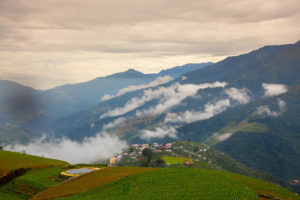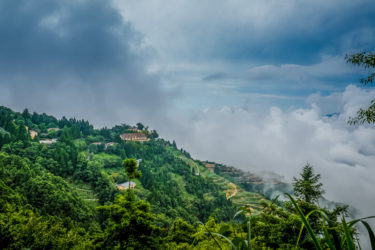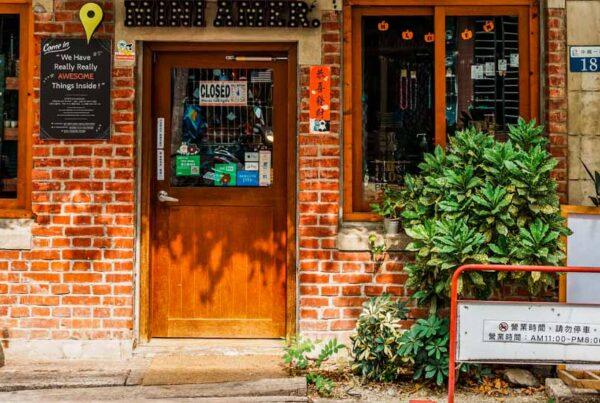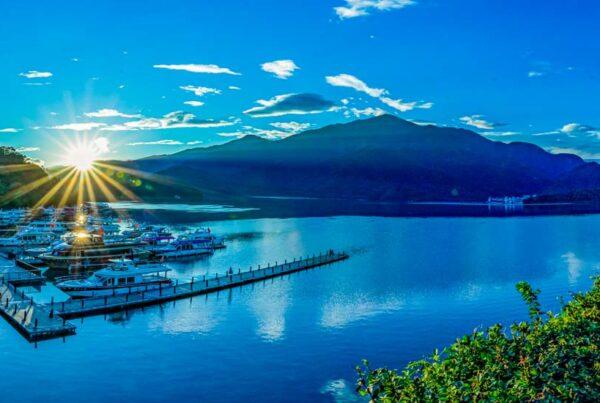Exploring Sun-Link-Sea and the Mountain Areas of Zhushan and Lugu Townships in Nantou County
TEXT: RICK CHARETTE
PHOTOS: RAY CHANG
Let’s spend a few days up on a mountain massif in Nantou County, hunting magical forest escapes, “seas of clouds,” lost-world waterfalls, comely suspension bridges, fireflies, the Swinhoe’s pheasant, the Reeve’s muntjac… armed with camera and pen.

For some, happiness is sitting on a perch by an ocean beach contentedly watching the waves washing up, one, then another, ad infinitum. Not for me. Spawned in a little former logging town by a river in the mountains of Quebec, this lad grew up far from the repetitive sea, and bliss for me is tracing a babbling brook and chasing bracing winds swishing up and down river valleys through trees locked arm in arm in dense formation, whistling tall and proud in t(h)ree-part harmony.
Which brings me to Nantou, Taiwan’s only landlocked county, a land of ever-higher mountains where broadleaf and coniferous forests meet and mingle in vast swathes of varied-hue greens, canvas topped with broad brushstrokes of sky-blue.

Following, we will be spent on a mountain massif with popular forest resorts occupying high-elevation valleys as our two key targets: the Sun-Link-Sea Forest and Nature Resort, its main area at an elevation of about 1,600m, and the Xitou Nature Education Area, its main area about 1,150m up. The launch-site for our upland peregrination is the western-flatlands town of Zhushan, tucked against the central-mountains base. County Road 151 flies us to Xitou, and from there it’s County Road 95 to Sun-Link-Sea. We’ll introduce our regional attractions in “reverse order,” starting at high-point Sun-Link-Sea and then journeying downhill.
Breezy Days in Sun-Link-Sea
On the final approach to Sun-Link-Sea on the 151 the road hugs the steep side of the massif much nearer its roof than its basement, providing a lordly view. Off to the right across a valley the plunging end of a mountain spur is seen, sharp-angle slopes carpeted with neat-line tea bushes, the spur capped with bright-color plantation buildings, demanding road-side photo stops. The western flatlands are espied in the far distance beyond.

A tunnel entrance appears. Out the other end your ambience alters dramatically. You are high up in a deep valley that has walls quickly closing in up ahead. This is the landscape of a long, narrow “forest and nature resort,” a privately operated getaway idyll (NT$250 entry fee). The valley has been carved by the Jiazouliao Stream. The area is remote and pristine, spread over an elevation of 1,600~1,880m, and ecotourism is the clarion call here.
Note: A shuttle-bus service is available for those not keen on long walks, moving you to different points on the main resort road (NT$40 adults, full distance one-way).
At the upper end of the resort road is at Songlong Rock Waterfall – also the upper-end shuttle-bus terminus. I vote for this as the prettiest waterfall location I’ve come across in Taiwan. Too perfect, like a movie set created for overly enthusiastic Lost Horizon or Jurassic Park shoots. At the base of a Cinemascope-wide semi-circular cliff is a large, deep green lagoon busy with fish in the water and eye-catching birds above. Two massive mid-lagoon boulders are covered completely with vegetation, trees “impossibly” growing atop their solid-rock bed. The cliff’s base is “gone,” to a height of 30 meters and a depth of 30, a cave now where once soft sandstone was emplaced. A paved pathway takes you along the cliff base and through the gaping hole, and you emerge directly before the waterfall itself, at its base. The waters spray down from on high, bouncing off the protruding tiers of the cliff.


Before all this, where the waters of the lagoon reform into stream-formation once more for their downhill run, is the cherry-red 99 Suspension Bridge. The path to the highest attraction in Sun-Link-Sea, Tian Di Yan, begins beside the bridge. “Tian Di Yan” literally means “Heaven and Earth Eyes” – two large erosion holes on the streamside cliff, eight and six meters wide respectively, that are the “eyes of Heaven seeing everything on Earth,” and into the souls of human visitors – here at the “top of the world.”


At the expansive Herb and Flower Garden, laid out appealingly like a chateau’s gardens, you are guaranteed that something will be a bloomin’ whatever your arrivin’ season. All focus is on temperate-climate plants at what is a flower and medicinal-herb botanical research and teaching center. Here is the calendar for tourist-favorite floral celebrities: tulips Jan~Mar, peonies and rhododendrons Mar~May, Taiwan azaleas Mar~Jun, violet Mexican sage flowers both May/June and Oct/Nov, hydrangea Sep~Nov, golden bell flowers year-round.

Beside the garden, at our time of visit a grove of young, planted maple trees was just past premium autumn-color display, inducing a bittersweet bout of homesickness for this writer, who has not seen the Eastern North America fall maple colors in many seasons. Resort cultivators have planted maple trees all around the area to add extra color splashes.

Found along the lower stretch of the Jiazouliao Stream section that courses through Sun-Link-Sea is Shijing Ji, a collection of potholes in the stone stream-bed, the deepest 5.5m, formed over millennia by stones caught in depressions by high-water eddies, endlessly circling and digging. Just above this geological gem is a manmade one, the 88 Suspension Bridge, which connects the long, easy-grade, foliage-shaded paved pathways that run along the lower-section sides of the stream. Not far downstream is the soaring 116m-high Qinglong Waterfall, taken in from upper and lower viewing decks, the waterfall and its gorge serving as a superb “headward erosion” classroom.



Note: The photos seen on these pages were taken in late autumn, when water levels are low. In spring/early summer the waterfall/cascade visual effects are accompanied by “thunderous roar” sound effects.
The resort has a range of accommodations. Its venerable Sun-Link-Sea Hotel stands between two broad bends in the Jiazouliao in its only open-flatland area, near its mid-point. Its European-décor rooms sleep up to four, Japanese-style tatami rooms up to six. Amenities include a sunlit fitness area, large gift shop, spa facility, karaoke facility, and art shop.
Room rates start at NT$3,080; Chinese-style breakfast buffet included; guests have resort entry fee reimbursed.



Bright Stars, Brighter Fireflies

Each night two free Chinese-language guided outings are offered – a firefly tour at 6:30 and a stargazing session at 7:30. The former launches from the Red Building, a retail center where premium local teas, art, etc. are sold, taking visitors up a forest trail. Gather for the latter at the hotel and enjoy stargazing from the hotel roof. A cherished bonus prize for Travel in Taiwan team members who lingered in the dark forest for star-photography after the firefly flirtation was the fleeting presence of a rarely seen Reeve’s muntjac, blissfully unaware of us for many precious moments that will long be valued.
Sun-Link-Sea Forest and Nature Resort
(杉林溪度假園區)
Add: No. 6, Xishan Rd., Da’an Borough, Zhushan Township, Nantou County
(南投縣竹山鎮大鞍里溪山路6號)
Tel: (049) 261-1217
Website: www.goto307.com.tw
Hotels in Zhushan Township (booking.com)
Between Sun-Link-Sea and Xitou – Wangyou Forest
Beside County Road 95, a few kilometers from Sun-Link-Sea, you’ll see a large “Wangyou Forest” sign (purple with white Chinese characters) between a parking lot and a timber-façade tea-selling outlet. From there, a narrow road leaps up past tea fields, tilted at startling angles. Take the 15-minute huff-and-puff walk up to the forest-entrance path (NT$50 entry), or use one of the privately-operated shuttle vans (NT$200 return). Wangyou Forest is a section of tall-pine forest drowned when the creek that gurgles through was blocked by Taiwan’s infamous 921 Earthquake in 1999. The result is a photographer’s dream, ethereal and enchanting, a place of otherworldly spirit right out of the Lord of the Rings.



Tip: Back on the main road, from this point up to the aforementioned tunnel, and downhill about a kilometer to the Liulongtou lookout (clear roadside signage), are open-view points through the trees splendid for enjoying Taiwan’s quintessential “sea of clouds” phenomenon – tremendous sunrise/sunset cloud banks rushing in to fill up deep valleys bottom to brim. The Sun-Link-Sea valley itself is too shallow for this to occur.
Xitou Nature Education Area

Your purpose at Xitou Nature Education Area (NT$200 entry fee) is to walk among the trees, in forest cover with a soaring canopy. The trails here thread through the woodland like a spider’s web. The area takes up 2,485 hectares. Cultivated within – this is an experimental station, established long ago by the Japanese – are, among other timber denizens, tracts of bamboo, pine, cedar, cypress, and gingko. Xitou is home to some 300 species of tree and 85 of bird, migratory and domestic.
Just inside the main gate, to the right, is a sturdy suspension bridge, clear-water stream flowing underneath, which leads to the area’s most popular walk. This paved circuit, an easy few kilometers, is for the most part graced with a leafy green canopy. It twists in a wide, gently-graded loop, delivering you back to the main gate and the busy cluster of accommodation facilities, small eateries, shops, and entertainment facilities right outside.
Among the highlights for visitors is University Pond, originally a logging-industry pond used to keep cut timber moist, today spanned by a high-arch bamboo bridge and home to a busy community of frogs and well-fed carp. Other attractions are the 180m Sky Walk, Taiwan’s first-such forest facility; a seedling nursery; a “bamboo house” made entirely of bamboo, including the furnishings; a mountain overlook and astronomical observatory; and an eco-exhibition center.
Xitou Nature Education Area
(溪頭自然教育園區)
Add: No. 9, Senlin Ln., Lugu Township, Nantou County
(南投縣鹿谷鄉森林巷9號)
Tel: (049) 261-2111
Website: www.exfo.ntu.edu.tw/sitou/eng
Further reading on other sites
Just outside the Xitou Nature Education Area is the Xitou Monster Village a quirky monster-theme park/shop/hotel complex.
Read a detailed introduction to the place on Nick Kembel’s blog site Spiritual Travels: Visiting Xitou Monster Village in Nantou, Taiwan
Le Midi Hotel Chitou
Le Midi Hotel Chitou is THE prestigious name for accommodation at Xitou, a veritable high-mountain hideaway oasis of regal splendor amidst a world of tall trees and rugged mountains. Set in a narrow side valley off County Road 151, just below Xitou, it appears abruptly when rounding a bend, standing like a proud European chateau transported to Taiwan’s mountains.

The owners are avid hunters of European-nobility antiques, and eager to show them off. In the lobby and other areas you are regaled with imperial-French furniture, clocks, and other curios collected on hunting forays in Europe.

The guestrooms are all spacious and tastefully appointed in modernistic continental European style, with bright nature-evocative green, white, and brown tones predominant.
Room rates start at NT$11,000; one dinner and breakfast included

One’s complimentary buffet dinner and breakfast are taken in the Miller Hall, a Western-style restaurant of French-chateau ambience with large windows and a wide-angle view of the hotel’s heated outdoor pool, which is backed by a tall man-made cliff with waterfall. The repasts are an international culinary medley.


At dinner you are feted with live musical entertainment (after dinner the entertainers move to the sumptuous Lobby Bar, where European royal blue is the theme). Best of the best at dinner on the night of this writer’s recent visit, in his humble-yet-confident gourmand opinion, was the smoked salmon and pig trotter, best at breakfast the fresh mountain produce salad bar.


The amenities are too many, in the sense that my word-space limitations necessitate recommendation triage. The usuals, by definition, are of course all here – outdoor pool, games room, gym, et cetera. But what I want most to tell you about are the clever uncommons (yes, I made that word up). Highlight selections? The mini-cinema with plush sofa seating showing recent family-friendly English-language flicks. The foot-soak/foot-massage area. The Zen Living tea-enjoyment room.

The hotel offers a shuttle-bus service to/from Taichung’s High Speed Rail station, with runs in either direction twice a day. Reserve seats at least 24 hours ahead.
Le Midi Hotel Chitou
(米堤大飯店)
Add: No. 1, Miti St., Neihu Village, Lugu Township, Nantou County
(南投縣鹿谷鄉內湖村米堤街1號)
Tel: (049) 261-2222
Website: www.lemidi-hotel.com.tw

Getting There
The Taiwan Tour Bus service has a 1-day guided tour from central Taichung that takes you to Xitou and two sites in Xiaobantian (www.taiwantourbus.com.tw). The Taiwan Tourist Shuttle hop-on/hop-off service (en.taiwantrip.com.tw) offers the Xitou Route from Taichung’s TRA and High Speed Rail stations, with stops in Zhushan, Lugu, and Xitou, and at the Le Midi hotel. The bus will make the trip further uphill to Sun-Link-Sea if you inform the staff/driver before getting on the bus at one of the two train stations. Taichung Bus (www.tcbus.com.tw; Chinese) No. 6871 buses run from central Taichung to Sun-Link-Sea, with stops at Lugu, Xitou, and Wangyou Forest.
Other Area Jewels
Here is a collection of other locations well worth your time between the Sun-Link-Sea/Xitou area and Zhushan. As mentioned in the opening, we start with the highest in elevation and end with the lowest (the Sky Ladder Scenic Area an outlier).
County Road 151 passes through quiet Lugu town, for which renowned Mt. Dongding serves as picturesque backdrop, slopes covered in the long lines of bushes that give birth to the district’s main tourist attraction, fragrant Dongding Oolong Tea. Tea shops and factories line the town’s main drag bottom to top, which bursts to life with avid buyers from the lowlands on weekends and holidays.
County Road 56 takes you out of town to the other side of Mt. Dongding, where more neat tea farms await along with a picture-perfect bonus, serene Qilin Lake. This is a manmade attraction; in the late 1800s two dominant farming clans in the area agreed to block the basin between the mountains here, creating a reservoir used for irrigation. Walk the round-lake trail – most mornings and evenings a thin fog forms over the water, cultivating an air of mystery, and there is good lakeside firefly-spotting from the end of March through mid-May.

From Lugu town, take County Road 55-1 across Beishi River to the other side of the valley, entering the Xiaobantian Scenic Area. “Xiaobantian” means “Little Half Heaven/Sky” – reference to the area’s halfway-status between Zhushan and Lugu. This district is centered on three small high-country farm villages that gathered forces to focus on agro/eco-tourism after the 921 Earthquake. Bamboo is king here, and augmenting the magnetic scenery siphoning in tourists, homestay experiences are now front and center along with innovative local-theme DIY and other experience activities.
You’ll come to the Xiaobantian Lookout as you climb the river-valley wall up to the plateau the farm villages inhabit, from where you can look back at the magnificent bright-red bridge you’ve just traversed, Xiaobantian Bridge, opened in 2014. This is mountainous Nantou County’s highest extradosed bridge, its roadbed 60 meters up from the valley floor. Its soaring grey towers are shaped like giant bamboo stalks, just like Taipei’s famed Taipei 101 tower.

Xiaobantian is home to numerous fetching waterfalls, Dexing Waterfall perhaps the best-known. On the higher reaches of a boulder-strewn Beishi River tributary stream, it has two sections, the upper, 30m high, has carved a cool, calm pool at its base perfect for wading.

During its rugged imperial-era pioneering days Taiwan was wracked by riots, rebellions, and other forms of civil strife. The last battle in the great 1787-1788 Lin Shuang-wen Rebellion, say local authorities, occurred at Xiaobantian’s “Moso Bamboo Forest Ancient Battlefield.” The site is beside County Road 55, the Chinese site-name characters carved in stone on a commemorative wall. A trailhead right behind sets walkers out on two long, interconnected pathways that pierce a vast forest of still-cultivated moso bamboo said to have been planted by the mainland China settler-forefathers of the local farm folk.

From Zhushan town you can take County Road 49, which runs roughly parallel to County Road 151, south and then turn right onto Dinglin Road, which takes you to the Sky Ladder Scenic Area entrance (NT$50 adults). A well-maintained trail brings you down, down, relentlessly down to the bottom of Taiji Gorge. Your joints, calves, and thighs will be well tested. Moving through thick bamboo forest, among your gorge-bottom rewards will be the Sky Ladder – a suspension-bridge engineering marvel – a sheer-cliff cave-dwelling Earth God temple below it, and Qinglong Waterfall. Unexpected bonuses in this soothingly sedate environment were my first-ever sightings (two!) of the neon-blue-plumage Swinhoe’s pheasant.


BeYoung Garden
Should you be famished be the time you arrive in Zhushan town, this new restaurant is both your answer and a delight. Tantalizingly, it’s on the second (top) floor of a still-operating small inter-town bus station that looks like a set for a 1950s period movie. “Zhushan” literally means “Bamboo Mountain”; the area is renowned for bamboo cultivation and products, bamboo is a key restaurant decorative material, and the chefs make edible bamboo a prominent ingredient. Specially recommended: the “three-cups mushroom bitter-tea range chicken” and “dried bamboo with soy-braised pork” set meals.


Add: 2F, No. 27, Caiyuan Rd., Zhongshan Borough, Zhushan Township, Nantou County
(南投縣竹山鎮中山里菜園路27號2樓)
Tel: (04) 9265-6176
Website: www.facebook.com/BeyoungGarden
A Trip to High Mountain Farms (WULING, FUSHOUSHAN, LISHAN)
taiwaneverything.cc/2016/05/15/a-trip-to-the-high-mountains-of-taiwan/
Trip to GUANWU — Mountains, Forests, and Clouds
Other articles about Nantou
Scenic Attractions in Central Taiwan’s NANTOU County
AOWANDA National Forest Recreation Area
QINGJING FARM and HEHUANSHAN
Further reading on other sites:
Synapticism: Postcards From Zhushan 竹山明信片
About the author

Rick Charette
A Canadian, Rick has been resident in Taiwan almost continually since 1988. His book, article, and other writings, on Asian and North American destinations and subjects—encompassing travel, culture, history, business/economics—have been published widely overseas and in Taiwan. He has worked with National Geographic, Michelin, APA Insight Guides, and other Western groups internationally, and with many local publishers and central/city/county government bodies in Taiwan. Rick also handles a wide range of editorial and translation (from Mandarin Chinese) projects.

















